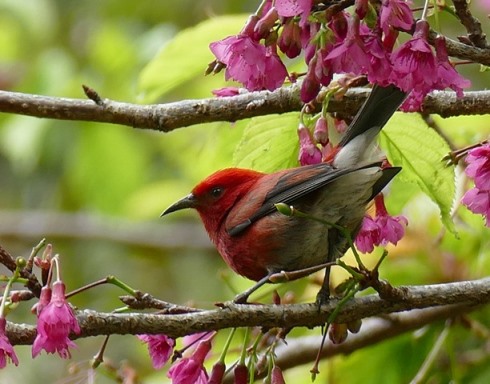
The Apapane is just one of these islands’ many fascinating endemics. Photo: Derek Lovitch
It might be the 50th state, but birding Hawai‘i feels like a world away. Without vagrancy, no remote islands would have land birds. Here, on one of the world’s most remote archipelagos, the chance arrival of far-flung waifs—a rosefinch and a monarch flycatcher from the East, and a solitaire and several waterbirds from North America—led to mind-blowing adaptive radiation that resulted in the evolution of a host of unique species. The ancestral finch, for example, gave rise to the Hawaiian Honeycreepers, which have developed such a huge range of shapes, sizes, and especially bills, from curlew-like curves for probing cavities to grosbeak-like seed-smashers, that some argue the honeycreepers even put “Darwin’s Finches” to shame. Unfortunately, the one variable that these species have in common is a tough time adapting to the arrival of humans. Since the first Polynesians arrived in the islands, hunting, habitat loss, introduced avian diseases, and introduced predators have rapidly lead to a marked decline in native forest birds. This tour will celebrate the species that persist despite the myriad threats. We hope not only to raise awareness and spur more support for their conservation, but also to marvel at the adaptations of some of the most unique species in the world. And let’s be brutally honest here—we may simply not have time to wait much longer to see some of these amazing birds.
Happily, not all of the news in Hawaii is dire. Due to the herculean efforts of local conservation groups to reduce the threats brought by introduced cats, mongooses, and rats—seabirds and waterbirds are not only surviving but, in some areas, thriving. The Nene (Hawaiian Goose) has staged quite the comeback, and in some areas native waterbirds such as the endemic Hawaiian Duck (Koloa Maoli), Hawaiian Coot (‘Alae Ke‘oke‘o), and endemic subspecies of Black-necked (Hawaiian) Stilt (‘Ae‘o), Black-crowned Night-Heron (‘Auku‘u), and Common (Hawaiian) Gallinule (‘Alae ‘Ula) are still common. Thanks to fencing and conservation, some of the pelagic species that nest on the Hawaiian Islands are recovering as well. While we will not shy away from understanding and discussing the problems for native birds, we’ll also relish the hope of promising new efforts and strategies. In the developed lowlands, lush forest patches filled with introduced vegetation, teem with a host of introduced birds from all corners of the globe. Despite the “unnatural” state of these areas and their new avian denizens, we’ll enjoy them—from the smallest waxbills and finches to the largest francolins and pheasants
And let us not forget that, as of 2017, Hawai‘i has been added to the “ABA Area”! A wealth of species, from endemic landbirds, remote seabirds, and established introductions from across the globe, have virtually no chance of being seen on the mainland—there’s a whole suite of new additions to your list to be found in one place, right here in the United States! Furthermore, it is our hope that the addition of Hawai‘i to the ABA Area will also serve to bring increased awareness of and conservation support to the plight of some of the most endangered species in the world. Perhaps this tour will be one small part of the effort to get more funding for this important cause, one that transcends our listing goals.
Day 1: The trip begins on Oahu this evening at 6:00pm in the lobby of our group hotel where we will have an introductory meeting and dinner. Night in Waikiki.
Day 2: We’ll begin our birding from right out the front door of our hotel, where White Terns (Manu-o-Ku) will be wheeling over the spreading trees of Queen Kapiolani Park. Pacific Golden-Plovers should be patrolling the field edges, and everywhere we look there will be a wealth of introduced birds, such as Common Myna, Red-crested Cardinal, Red-vented Bulbul, Yellow-fronted Canary, Java Sparrow, Common Waxbill, Spotted and Zebra Doves, and Rose-ringed Parakeet. After the park we will leave the city behind and head a bit inland for our first taste of forest birding. We’ll first seek out Oahu’s only remaining endemic species of honeycreeper in the hills above Honolulu: the Oahu Amakihi. Later in the day we’ll concentrate our attention on a coastal forested valley, where along a short but somewhat steep trail we will hopefully encounter the engaging (and endangered) Oahu Elepaio, an endemic species of Monarch Flycatcher. Not all of the introduced species on the island prefer city parks, and while on our endemic bird adventure we could also encounter White-rumped Shama, noisy flocks of Red-billed Leiothrix, an occasional Red-whiskered Bulbul, and chattering groups of Warbling White-eyes. Night in Waikiki.
Day 3: Today we’ll journey up the picturesque windward side to experience the serenity of Oahu’s Northern Shore in search of visiting shorebirds, such as Wandering Tattler and sought-after Bristle-thighed Curlew (Kioea). While cruising the coastline, famous for world class surf beaches and secluded coves with basking sea turtles, we are sure to find a few more flashy introduced species, such as the Saffron Finch and the handsome Chestnut Munia. We’ll certainly stop at the large salt ponds near the US Airforce Base where with luck we should find foraging Hawaiian Black Noddy chasing small schools of baitfish around in the shallow waters. This subspecies greatly differs from other Black Noddies, with an ash gray rump and tail, all gray crown and nape and bright orangish feet and legs. As it is resident around the islands, and breeds on rocky cliffs rather than in bushes (like other Black Noddies), it would seem to be an excellent candidate for full species status. The North Shore is also home to some of the last extant family farms on Oahu with crops of coffee, cacao, eggplant, papaya, pineapple, apple banana, and even scattered shrimp farms with endemic Hawaiian Coot (‘Alae Ke‘oke‘o) and three endemic subspecies: Common (Hawaiian) Gallinule (‘Alae ‘Ula), Black-necked (Hawaiian) Stilt (‘Ae‘o) - surely another prime candidate for splitting - and Black-crowned Night-Heron (‘Auku‘u). Depending on our timing, we may spend the evening seawatching for the likes of Wedge-tailed Shearwater (‘Ua‘u Kani), Brown Noddy (Noio Koha), and Brown and Red-footed Boobies (‘A). We’ll keep a close eye on the Rare Bird Alerts for any exciting vagrants, which can come from either side of the vast Pacific! Night in Waikiki.
Day 4: After breakfast we’ll take a morning flight to the Big Island. We’ll spend the rest of the day investigating the human-altered lower slopes of Mauna Kea, casually birding along Saddle Road looking for the endemic subspecies of Short-eared Owl, and introduced Eurasian Skylark, Chukar, California Quail, Wild Turkey, Erckel’s Spurfowl, and Black and Gray francolins. Around Waikoloa we may also find our first Chestnut-bellied Sandgrouse, Saffron Finch, African Silverbill or Red Avadavat. The lush plantings around our excellent Kona Hotel can be good for a wide variety of introduced birds as well, with Saffron Finches, Yellow-billed Cardinal and several finches all likely. Night in Kona.
Day 5: For our second day on the Big Island we will again drive up the slopes of Mauna Kea, this time heading over to the windward side, high up on the volcanos Northeastern slopes in search of native birds. We’ll be largely birding at the incomparable Hakalau Forest Reserve, a site that is truly the mecca for Hawaiian Honeycreeper diversity. We’ll spend the day exploring the reserve, a publicly restricted site that is home to many of Hawaii’s endangered plants, native arthropods, and endemic birds. Some of the particularly noteworthy birds here include Hawaii Creepers, gorgeous day-glow orange Akepas, stunning long billed Akiapolaau, Hawaiian Hawk, and Omao (Hawaii Island’s endemic thrush). Our visit should coincide with the blooming period of the ancient Ohia trees, with beautiful I’iwi, Hawaii Amakihi, and Apapane all foraging over the bright red blossoms. Night in Kona.
Day 6: Today will bring a change of pace, as we embark on a pelagic birding trip from Honokohau Harbour. While onboard we will keep watch for a wide array of seabirds including Black and Brown Noddies, Sooty Tern, Wedge-tailed and Sooty Shearwaters, and Bulwer’s Petrel. Along with this nice suite of expected birds we may encounter some of the rarer local species such as Masked Booby, Hawaiian, Black-winged, Mottled, White-necked and Juan Fernandez Petrels, Newell’s and Christmas Shearwaters, Leach’s or Band-rumped Storm Petrel, all three jaegar species, South Polar Skua, and an array of possible cetacean species. Depending on the group’s energy level after the pelagic, we may have time for a bit of late afternoon birding for a few introduced birds, such as Black Francolin, Indian Peafowl, Red Avadavat, or Lavender Waxbill. We may stop at the Aimakapa Ponds and the Kealakehe Wastewater Treatment Plant where we would encounter a nice mix of wading birds and waterfowl. Night in Kona.
Day 7: Following breakfast we will head to the airport for a mid-morning flight to Lihue, on the Garden Isle of Kauai. We’ll immediately be struck by the contrast between the urban Honolulu area, the somewhat desert-like Kona, and this lush and mostly rural island with its small population and extensive forests. Along Kauai’s North Shore we will stop at the famous Kilauea Point National Wildlife Refuge, where the stunning coastline should host Red-footed and Brown Boobies, spectacular Red-tailed and White-tailed tropicbirds, leisurely soaring Great Frigatebirds, and in spring, the majestic Laysan Albatross. Because Kauai is miraculously free of mongooses, native waterbirds are much more abundant here than on any other of the main Hawaiian Islands and we should enjoy up close views of Hawaii’s state bird, the Nene, and the more subdued Hawaiian Duck, which on Kauai persist without the influx of domestic Mallard genes. Night in Lihue.
Day 8: Today we’ll get an early start to drive up through scenic Waimea Canyon, dubbed the Grand Canyon of the Pacific by the glossy tourist brochures. Soon enough we will arrive in the lush jade valleys of Koke‘e State Park, surely one of the most breathtaking landscapes in all of Hawai‘i. Here we’ll spend much of the day slowly walking along one of the park roads where Kauai ‘Elepaio, Kauai ‘Amakihi, and ‘Apapane are likely, and the increasingly scarce ‘Anianiau still a good possibility. Unfortunately there is now only a remote chance of the truly rare ‘Akeke‘e due to the continuing collapse of Kauai’s forest birds. Some non-native forest birds should be about as well, such as wild Red Junglefowl, Erkel’s Francolin, the skulky Japanese Bush Warbler, Red Avadavat, and melodious Chinese Hwamei. Night in Lihue.
Day 9: This morning will offer a second chance to head into the forest for any accessible missing Kauai species and perhaps the rare and beautiful Greater Necklaced Laughingthrush. We’ll search a few waterbird refuges for residents and migrants, and perhaps even have a few hours of R&R (you are on vacation, after all!). We’ll check out of our hotel in the late morning and head to the airport to connect with flights home.
Updated: 17 November 2023
Prices
- 2025 Tour Price : $7,450
- Single Occupancy Supplement : $1,230
Notes

Questions? Tour Manager: Stephanie Schaefer. Call 1-866-547-9868 (US or Canada) or (01) 520-320-9868 or click here to email.
* Tour invoices paid by check carry a 4% discount. Details here.
Maximum group size 8 with one leader or 11 with two leaders.
Note: Although there are endemic landbirds on the island of Maui, there is not – at this time – any opportunity for commercial tours to bring birders into the forest reserves. All of the endemic waterbirds and landbirds can be seen on other islands, and therefore this tour does not include a visit here.
